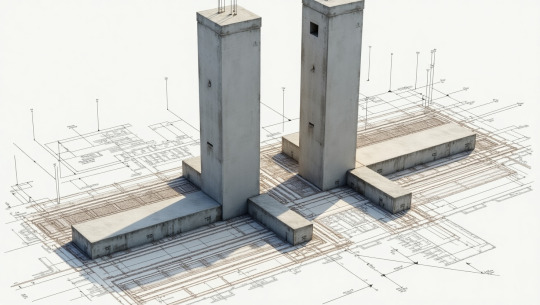#FootingDesign
Explore tagged Tumblr posts
Text
What Is a Cantilever Footing and When Should You Use It?

When building a house or any structure, the foundation is crucial—it’s what keeps everything stable and secure. But what happens when you have limited space, uneven loads, or tricky property lines? That’s where specialized footings, like a cantilever footing, come into play.
In this guide, we’ll break down what a cantilever footing is, how it works, and when it’s the best choice for your construction project. Whether you're a homeowner planning an extension, a student learning about foundations, or a junior engineer exploring design options, this post will give you a clear understanding.
What Is a Cantilever Footing?
A cantilever footing (also called a strap footing) is a type of foundation used when two columns are close to each other but can’t share a single footing due to space constraints or load differences. Instead of a traditional combined footing, this design uses a reinforced concrete "strap" or beam to connect two separate footings, allowing one side to extend (or cantilever) beyond its support.
Key Features of a Cantilever Footing:
Two individual footings connected by a beam.
One footing supports a heavier load, while the other balances it.
Ideal when columns are near property lines or existing structures.
Think of it like a seesaw—if one side is heavier, the other side needs a counterbalance. A cantilever footing works similarly, ensuring stability even when loads aren’t evenly distributed.
How Does a Cantilever Footing Work?
To understand how this footing functions, let’s break it down:
Uneven Load Distribution – If one column carries more weight (e.g., a structural beam or wall), its footing will be larger. The adjacent column’s footing is smaller but connected via a strap beam.
The Strap Beam’s Role – This reinforced concrete beam transfers part of the load from the heavier column to the lighter one, balancing the forces.
Prevents Tilting or Settlement – Without this connection, the heavier column could sink, causing cracks or structural failure.
Practical Example:
Imagine you’re building a house extension close to your neighbor’s property. You can’t place a wide footing on their side, so instead, you:
Install a larger footing on your side (where you have space).
Connect it to a smaller footing near the boundary with a strong strap beam.
This way, the load is safely distributed without encroaching on the neighbor’s land.
When Should You Use a Cantilever Footing?
Not every project needs this type of foundation, but here are common scenarios where it’s the best solution:
1. Limited Space Near Property Lines
If a column must be placed right next to a boundary (like a fence or adjacent building), a cantilever footing allows you to extend support inward rather than outward.
2. Adjacent Existing Structures
When expanding a building, you might need to add columns close to old foundations. A cantilever footing prevents interference with the existing structure.
3. Uneven Column Loads
If one column supports more weight (e.g., a load-bearing wall), a cantilever footing ensures the load is safely shared with a neighboring column.
4. Poor Soil Conditions
In areas with weak soil, spreading the load across two footings reduces the risk of sinking.
For a deeper dive into design specifics, check out this detailed guide on cantilever footing.
Cantilever Footing vs. Other Foundation Types
How does this compare to other footings? Here’s a quick breakdown:Foundation TypeBest ForKey DifferenceCantilever FootingUneven loads, tight spacesUses a strap beam to balance two footingsCombined FootingTwo close columns with similar loadsSingle, wider footing under both columnsIsolated FootingSingle columns with even soilStandalone footing per column
A strap footing is similar but often refers to a more rigid connection between footings.
Benefits and Limitations of Cantilever Footings
Advantages:
✔ Saves Space – Ideal for tight or restricted construction sites. ✔ Balances Uneven Loads – Prevents one column from sinking. ✔ Cost-Effective – Requires less excavation than deep foundations.
Limitations:
✖ Complex Design – Requires precise engineering to avoid failure. ✖ Not for Heavy Loads – Better suited for medium-weight structures. ✖ Reinforcement Needed – The strap beam must be strong enough to handle stress.
Design Considerations for Cantilever Footings
If you’re considering this footing type, keep these factors in mind:
Soil Bearing Capacity – Weak soil may need deeper footings or additional support.
Reinforcement – The strap beam must have steel rebars to resist bending forces.
Column Spacing – Too far apart, and the beam may bend; too close, and a combined footing may work better.
Professional Engineering Required – Always consult a structural engineer to ensure safety.
Final Thoughts
A cantilever footing is a smart solution when dealing with tricky construction scenarios—like tight spaces, uneven loads, or property line restrictions. By using a strap beam to link two footings, it ensures stability without compromising on space or safety.
However, proper design is crucial. If you’re planning a project that might need this foundation type, always consult an expert to ensure your structure stands strong for years to come.
#StructuralEngineering#FoundationDesign#ConstructionEngineering#CivilEngineering#BuildingDesign#StructuralDesign#EngineeringBasics#FootingDesign#ConcreteStructures#EngineeringDrawings
1 note
·
View note